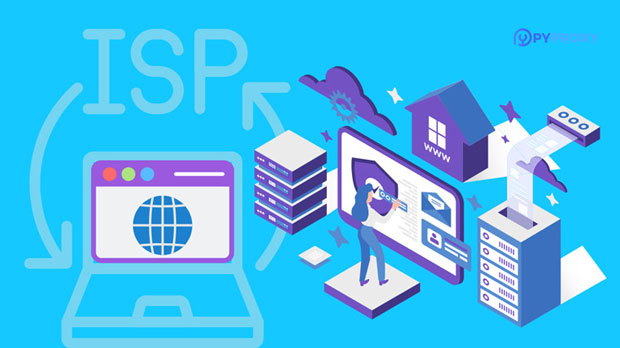Wireless proxy latency optimization is a crucial factor when managing online traffic, especially for businesses relying on fast and efficient data transfer. Two popular tools for wireless proxy services, PYPROXY and NodeMaven, are often compared for their performance in reducing latency. This article explores both platforms' capabilities, analyzing which one delivers faster results and how each can optimize wireless proxy latency. Whether you're a developer, network administrator, or someone interested in improving online data transmission, understanding the differences between PyProxy and NodeMaven is key to making an informed choice for your wireless proxy needs. What Is Wireless Proxy Latency?Before delving into the comparison between PyProxy and NodeMaven, it’s important to first understand what wireless proxy latency is and how it impacts network performance. Latency refers to the time it takes for data to travel from one point to another in a network. In the context of wireless proxy, it includes the delay involved in routing internet traffic through a proxy server, often located at a different geographic location.Wireless proxy latency can be influenced by several factors, including server location, network congestion, protocol inefficiencies, and the architecture of the proxy itself. Optimizing this latency is essential to improving user experience, ensuring faster loading times, and reducing the impact of delays on applications and services that rely on real-time data.Why Optimize Wireless Proxy Latency?The need for latency optimization in wireless proxy systems is increasingly critical, especially in industries where real-time communication, gaming, video streaming, and e-commerce are prevalent. High latency can lead to delays, slower load times, and a negative impact on user experience, potentially resulting in customer dissatisfaction. Furthermore, businesses rely on minimizing latency to stay competitive, particularly when handling large-scale operations and cross-border data transfers. As the internet of things (IoT) continues to grow, optimizing wireless proxy latency will become even more important to ensure smooth and efficient data transfer between devices.Introduction to PyProxy and NodeMavenBoth PyProxy and NodeMaven have gained traction in the realm of wireless proxy services. They each offer different technologies and approaches to reducing latency, and understanding their respective features and performance can help determine which is better suited for specific use cases.PyProxy: Overview and PerformancePyProxy is a Python-based proxy server designed with efficiency and simplicity in mind. It focuses on providing high performance through lightweight threading, which allows it to handle multiple requests with minimal resource consumption. PyProxy’s architecture makes it ideal for scenarios that demand rapid, high-volume data exchange with reduced overhead. Key Features of PyProxy:- Multithreaded design: This enables PyProxy to handle concurrent requests efficiently, reducing latency and ensuring that network traffic is processed faster.- Customizable settings: Users can fine-tune the proxy configurations to suit specific requirements, optimizing for different types of traffic.- Compatibility with Python libraries: As it is built on Python, PyProxy integrates well with existing Python-based tools and libraries, making it a good fit for developers working in Python-heavy environments.PyProxy is known for its speed and efficiency in proxy-based data transfer, especially in scenarios where low-latency performance is critical. However, its reliance on Python can introduce some limitations in terms of scalability and resource management in extremely large-scale applications.NodeMaven: Overview and PerformanceNodeMaven, on the other hand, is a Node.js-based proxy solution designed to offer low-latency performance and scalability. Leveraging the non-blocking I/O model of Node.js, NodeMaven can handle a high number of concurrent connections without experiencing performance degradation, making it suitable for applications requiring massive data throughput.Key Features of NodeMaven:- Non-blocking I/O: NodeMaven’s event-driven architecture allows it to process multiple requests without waiting for one to complete before starting another, drastically reducing latency.- Scalability: NodeMaven is highly scalable due to the inherent capabilities of Node.js, allowing it to perform well even under heavy loads.- Asynchronous request handling: This enables NodeMaven to be faster in managing large datasets and simultaneous requests, reducing waiting time for each connection.NodeMaven is an excellent option for developers who require high scalability and low-latency performance in proxy-based data transmission. Its design is optimized for environments where both speed and capacity are paramount, especially in large enterprise networks or high-traffic applications.Comparing Latency: PyProxy vs. NodeMavenWhen comparing PyProxy and NodeMaven in terms of latency optimization, there are several factors to consider, including the architecture, threading model, and scalability.- Performance in High-Volume Scenarios: NodeMaven, with its non-blocking I/O model, generally performs better in high-concurrency situations, as it can handle thousands of requests simultaneously without causing significant delays. PyProxy, while efficient in handling multiple requests, may experience some performance dips in scenarios involving a massive number of connections due to Python's GIL (Global Interpreter Lock) constraints.- Latency in Lightweight Operations: For small-scale applications or lightweight operations, PyProxy may offer a slight edge due to its simplicity and minimalistic design. It can efficiently handle lower traffic volumes with less overhead, providing a quick response time for basic use cases.- Scalability: NodeMaven’s scalability gives it a clear advantage in large networks or systems where high throughput is necessary. PyProxy may require additional configuration or resources to handle similar levels of traffic, which can increase latency over time.Choosing the Right Solution for Your NeedsSelecting between PyProxy and NodeMaven depends largely on the specific requirements of your use case. For developers focused on performance in a lightweight, Python-based environment, PyProxy may be the better choice. It’s easy to integrate and configure, making it an excellent option for smaller-scale applications or those where resource consumption is a concern.On the other hand, if your project demands high scalability, the ability to handle large volumes of data, and low-latency performance under heavy loads, NodeMaven is likely the superior option. Its asynchronous, non-blocking I/O model makes it ideal for high-demand environments, such as video streaming, large-scale e-commerce, or IoT systems.Conclusion: PyProxy vs. NodeMavenBoth PyProxy and NodeMaven offer excellent performance in wireless proxy latency optimization, each excelling in different scenarios. PyProxy provides speed and simplicity for smaller-scale projects, while NodeMaven’s advanced features and scalability make it the best choice for larger, high-concurrency applications. When choosing between the two, it’s important to consider your specific needs in terms of traffic volume, latency requirements, and system scalability.In conclusion, if you prioritize quick, low-latency operations in a Python-based environment, PyProxy may be the ideal solution. However, for larger-scale systems with high data throughput and concurrent request handling, NodeMaven stands out as the better choice, offering superior performance in high-volume environments.
Sep 19, 2025



































































